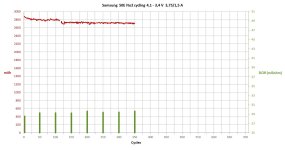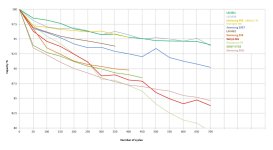flippy said:what is your indication why the 30Q suck so much?
spec sheet wise it should behave better.
If we read 30Q specification, it´s obvious that this cell was designed to provide high power output. Low internal resistance and high charge and mainly discharge currents is characteristic for high power cells, typical use is in accu tools.
From the 30Q spec it´s obvious that high power is preffered, not cycle life.
For high power cells in our cycling test is characteristic fast capacity loss in the first 20 cycles. 30Q is the most pronounced example, VTC6 is similar, strangely enough HG2 is evidently better. Obviously LG is leading both in high energy (MJ1, M36) as well as high power category.
Pajda is probably chuckling how much I am praising LG products now.
What is reason for such quick initial capacity loss ? Frankly, I don´t know. Maybe it´s connected to higher surface of electrodes, thinner electrodes and lower electrolyte amount to electrodes surface ratio. This lower ratio could lead to quicker loss of active lithium (loss of lithium inventory) during initial SEI build up. Silicon presence in the anode is aggravating factor. SEI growth leads to capacity fade due to the consumption of lithium that would otherwise be available for cycling.
NCA chemistry of 30Q and VTC6 may also be reason for generally worse capacity decline comparing to probably NMC chemistry of HG2, even probably NMC 811, according to this study :
https://www.mdpi.com/2313-0105/5/4/64/htm
View attachment Design Strategies for High Power vs. High Energy Lithium Ion Cells.pdf

It may be myriads of another reasons and their combinations. Frankly, I am not expert in this area and all above written is my pure speculation. I prefer testing of real samples instead of speculations.
I take the liberty to modify well known quote : One good test is worth more than a thousand opinions.





























